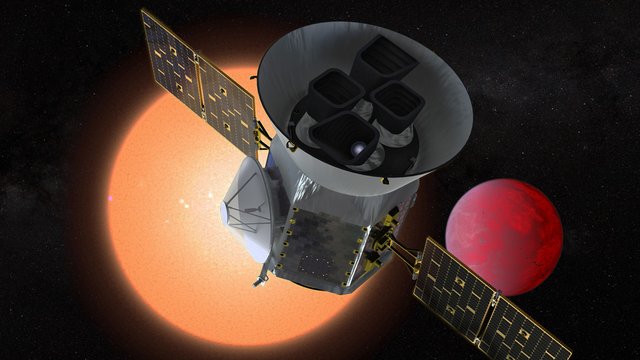Lesson .
.Telescope Tango: A 'Pi in the Sky' Math Challenge
Overview
The "Pi in the Sky" math challenge gives students a chance to take part in recent discoveries and upcoming celestial events, all while using math and pi just like NASA scientists and engineers. In this problem from the ninth set, students use the mathematical constant pi to calculate how far the TESS spacecraft travels as it sends data to Earth.
Materials
- Pi in the Sky 9: Telescope Tango worksheet – download PDF
- Pi in the Sky 9: Telescope Tango answer key – download PDF (also available as a text-only doc)
Background

Telescope Tango
The Transiting Exoplanet Survey Satellite, or TESS, is designed to survey the sky in search of planets orbiting bright, nearby stars. TESS does this while circling Earth in a unique, never-before-used orbit that brings the spacecraft close to Earth about once every two weeks to transmit its data. This special orbit keeps TESS stable while giving it an unobstructed view of space. In its first two years, TESS identified more than 2,600 possible exoplanets in our galaxy with thousands more discovered during its extended mission. In Telescope Tango, students will use pi to calculate the distance traveled by TESS each time it sends data back to Earth.
Procedures
Telescope Tango
NASA's TESS mission is designed to survey the entire sky in search of exoplanets, or planets orbiting stars other than our Sun. In its two-year primary mission, TESS identified more than 2,600 possible exoplanets and counting.
To locate exoplanets, the space telescope flies in a highly eccentric elliptical orbit, which had never been attempted before. This orbit, called P/2, minimizes the amount of time that light and heat from Earth and the Moon can interfere with data collection. And it still allows the spacecraft to make close passes by Earth to transmit data about its findings back to scientists. The spacecraft's 13.7 day orbit has an axis of 376,000 km at apogee and an axis of 108,400 km at perigee. Each downlink from TESS takes about three hours to complete.
While TESS actually moves at different speeds throughout its orbit – from 0.5 km/s at apogee to 4 km/s at perigee – if its velocity stayed uniform, how many kilometers would TESS need to travel to successfully transmit its data?
Assessment
Extensions
Participate
Join the conversation and share your Pi Day Challenge answers with @NASAJPL_Edu on social media using the hashtag #NASAPiDayChallenge
Blogs and Features
Related Lessons for Educators
Multimedia
Recursos en español
Facts and Figures
Missions and Instruments
Websites
Lesson Last Updated: June 20, 2025











